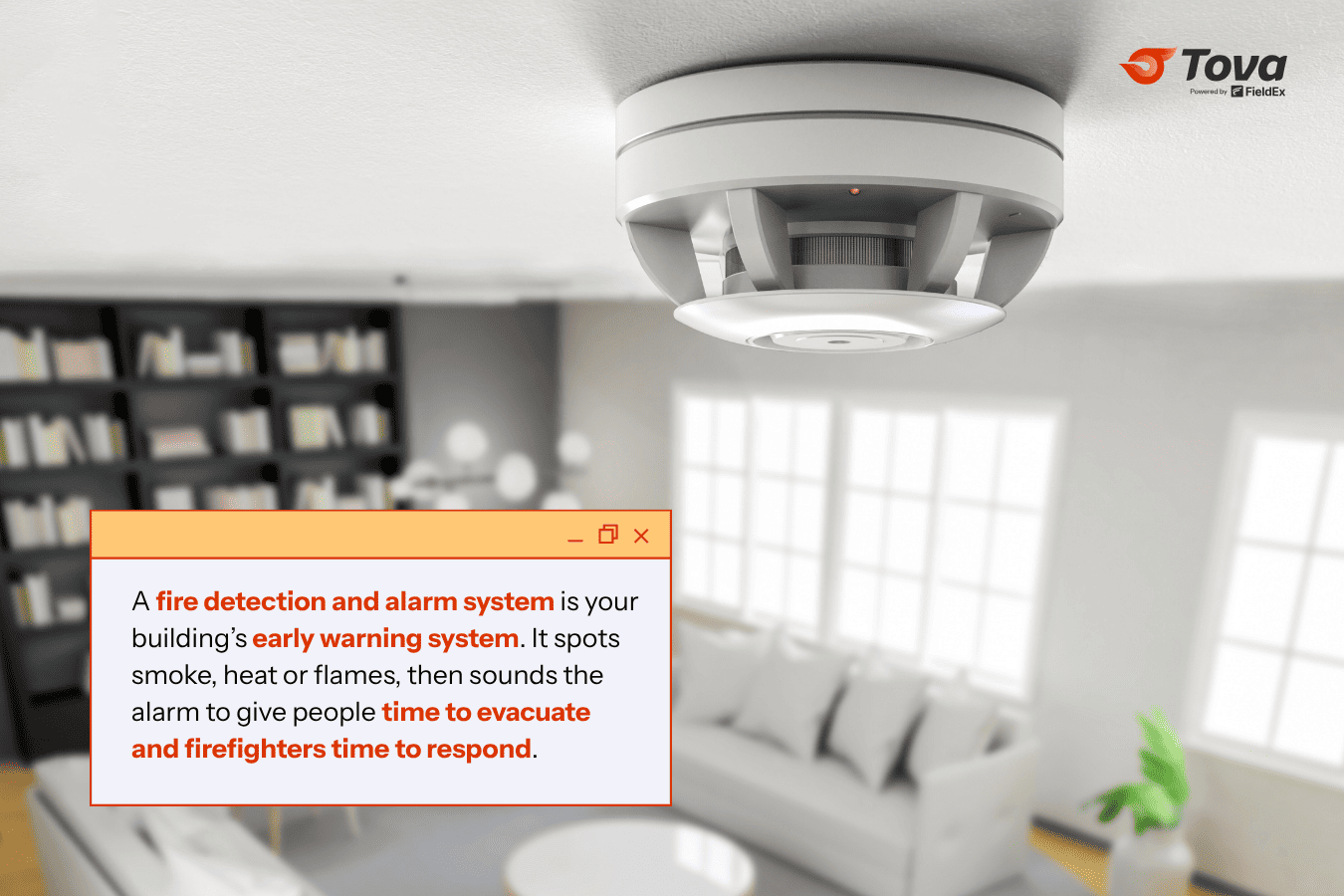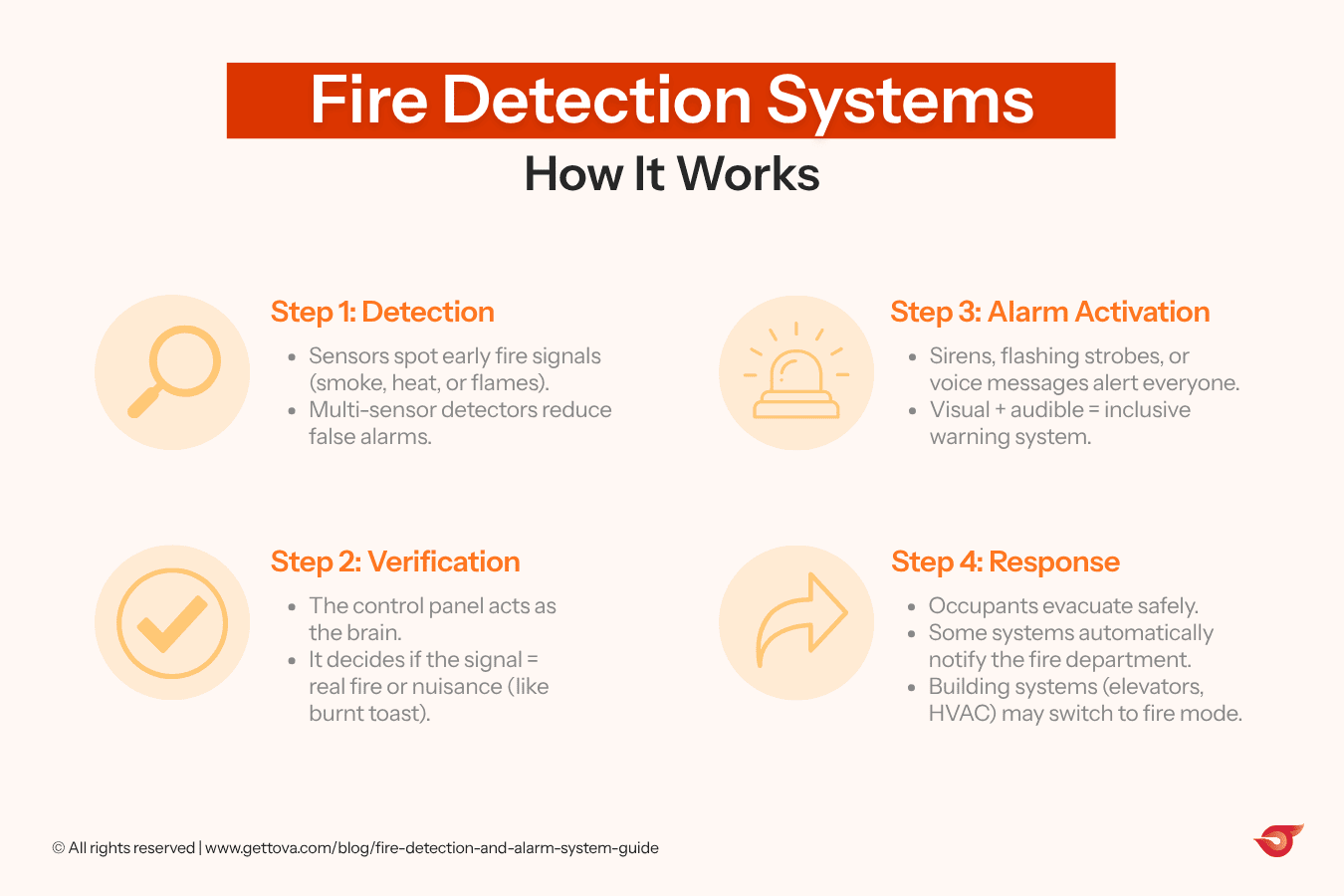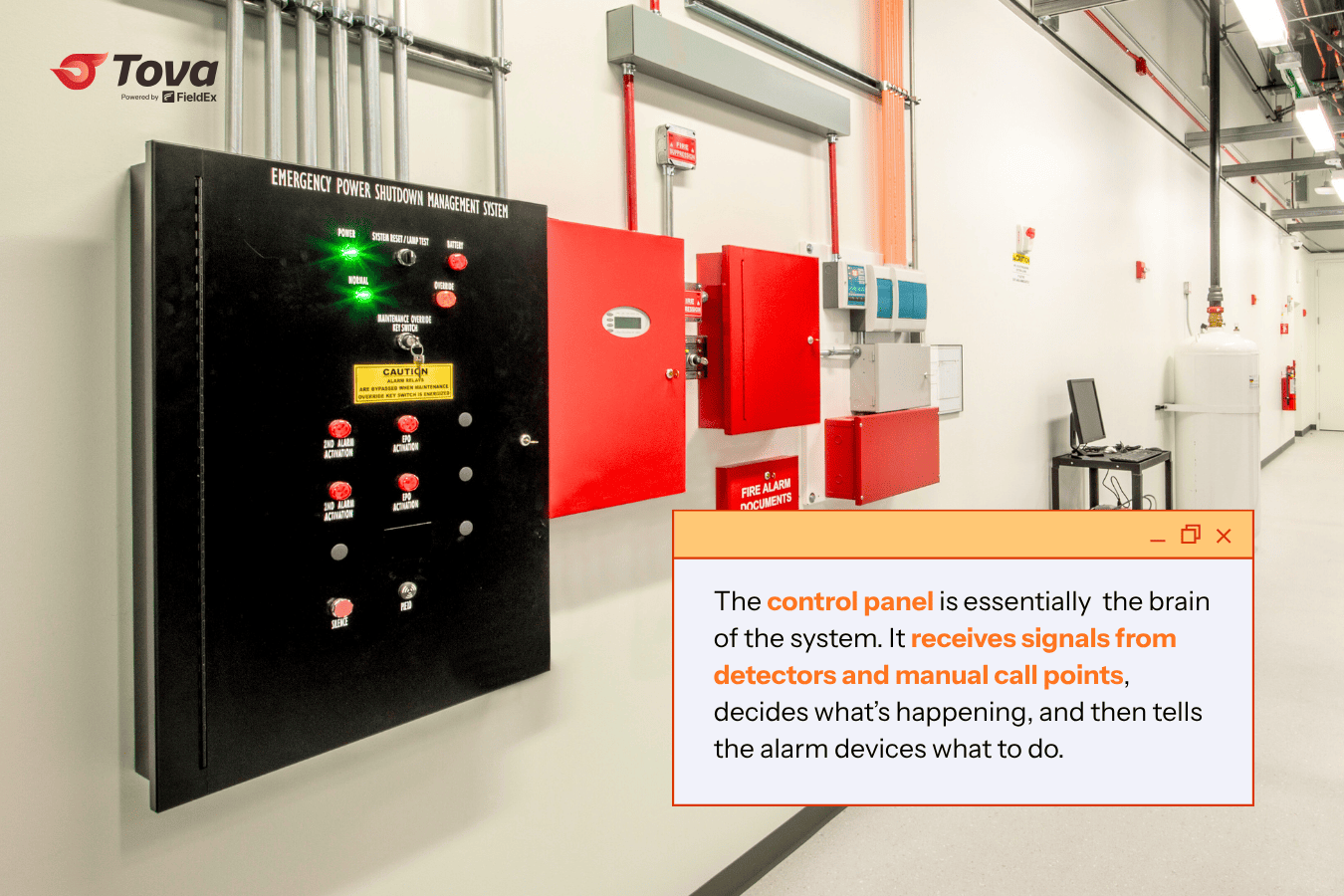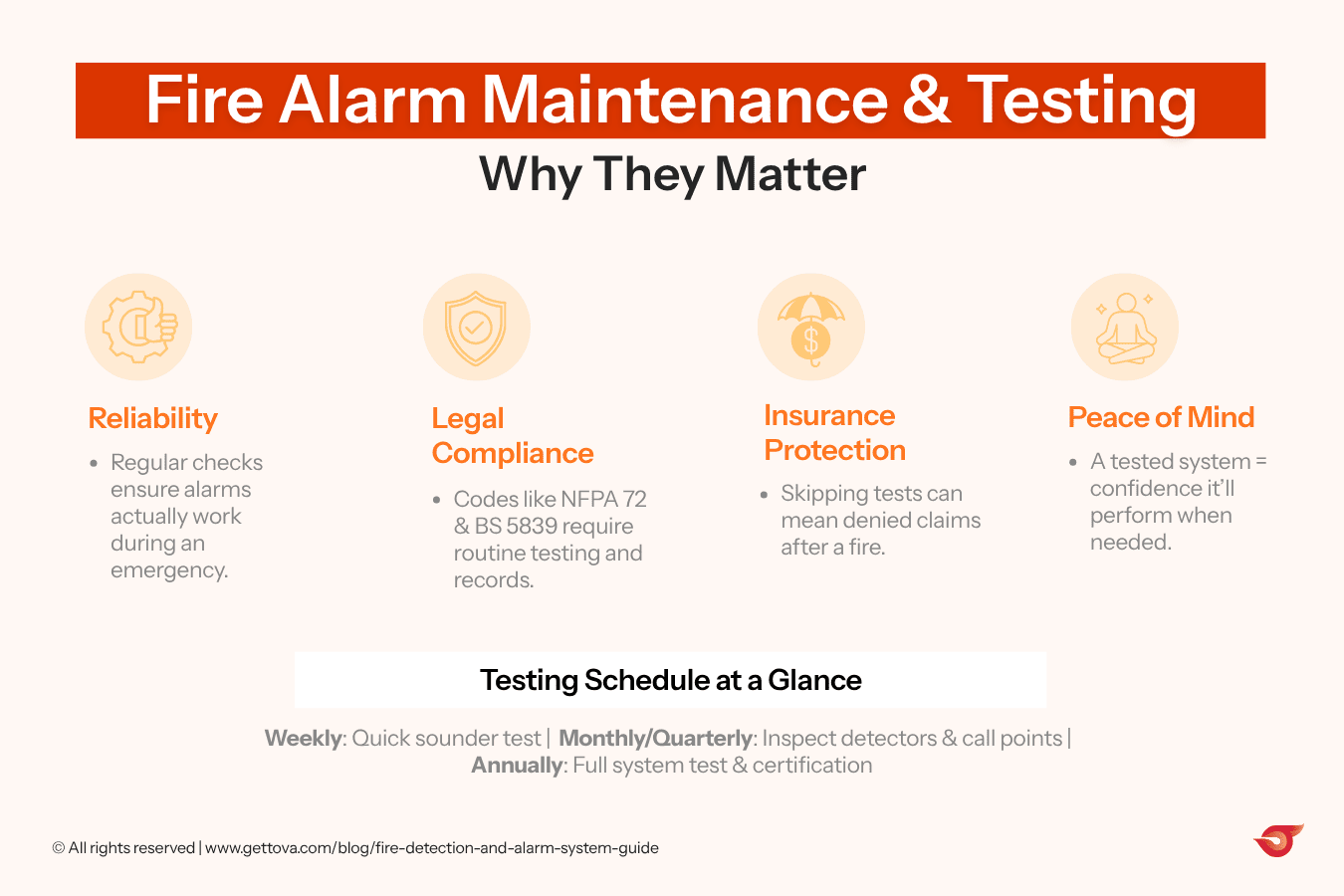
When it comes to fire safety, speed is everything. A blaze can double in size in under a minute, which means every second counts. That’s where fire detection and alarm systems step in – the unsung heroes that sense danger early and raise the alarm before things spiral out of control.
Put simply, a fire detection and alarm system is your building’s early warning system. It spots smoke, heat or flames, then sounds the alarm to give people time to evacuate and firefighters time to respond. In some cases, it can even notify emergency services automatically.
From the simple smoke detector in your home to complex addressable alarm networks in hospitals or airports, these systems are designed with one goal: keep people safe and minimize damage.
In this guide, we’ll cover what fire detection and alarm systems are, how they work, the main types and components, and why regular maintenance is just as important as installation. Ready? Let’s get crackin’!
A fire detection and alarm system is exactly what it sounds like: a setup that spots signs of fire early (smoke, heat or flames) and alerts people so they can act fast. It’s the building’s built-in “early warning system”.
Instead of waiting until a fire is raging out of control, these systems kick in at the first hint of trouble. That might be a tiny whiff of smoke, a sudden spike in heat, or the flicker of a flame. Once detected, the system sends a signal to a central control panel, which then triggers alarms – sirens, flashing strobes or even voice announcements.
Think of it as your building’s nervous system. Just like nerves detect pain and tell your brain to react, detectors sense fire and tell the alarm system to alert everyone inside.

At its core, a fire detection and alarm system follows a simple flow: sense → decide → alert → respond. The details get technical, but let’s break it down in plain English.
Special sensors pick up signs of fire. These can be:
Example: A heat detector in a kitchen notices a sudden temperature spike.
The control panel is the system’s brain. It decides if the signal from a detector is really a fire or just a nuisance (like burnt toast). Addressable systems can even pinpoint which detector triggered the alert.
Once verified, the system triggers alarms:
Depending on the system, several things can happen:
Example: Smoke in a server room sets off a detector → signal sent to control panel → sirens and strobes activate → IT staff evacuate while the fire service is notified.

Not all fire alarm systems are created equal. The “best” one depends on the size of the building, its purpose, and the level of detail you need when a fire breaks out. Here are the main types you’ll come across:
These are the old faithfuls of fire detection. The building is split into zones, and each detector in a zone is wired back to the control panel. If one goes off, the panel shows which zone triggered the alarm.
Here, every detector has a unique address. If one goes off, the control panel tells you exactly which device triggered the alarm.
As the name suggests, these systems use radio signals instead of cables. Detectors talk to the control panel wirelessly.
This is the high-tech option. ASD uses pipes that constantly suck in air samples and analyze them for even the tiniest particles of smoke.
Why choose one when you can mix and match? Hybrid systems combine wired and wireless technology, offering flexibility for buildings with varied needs.
Quick takeaway: Conventional systems tell you where roughly the fire is, addressable systems tell you exactly where, wireless makes life easier, ASD spots fires super early, and hybrids give you flexibility.
A fire alarm system isn’t just a detector and a siren. It’s a team of parts working together like a well-rehearsed orchestra. Here are the key players:
These are the system’s “senses”. Different detectors pick up different fire signals:
You’ve probably seen these red boxes with a little glass panel. If someone spots a fire before the detectors do, they can break the glass (or press the button) to raise the alarm instantly.
Think of this as the brain of the system. It receives signals from detectors and manual call points, decides what’s happening, and then tells the alarm devices what to do. In addressable systems, it even shows which detector was triggered.

Once the system decides it’s go-time, these devices make sure everyone knows:
No power = no alarms. That’s why every system has a primary power source (usually mains electricity) and a backup battery that keeps it running during outages.
Pro tip: In large buildings, you’ll often see fire alarm schematics with arrows connecting these components.
It’s easy to confuse fire detection systems with fire suppression systems, but they serve very different roles. Think of it this way:
Both are critical. One without the other leaves a gap in your safety net.
Takeaway: Detection warns you early, suppression fights the flames. The best fire safety strategies always use both.
Fire detection and alarm systems aren’t just “nice to have” – they’re legally required in most buildings. The exact rules vary depending on where you are, but the goal is always the same: make sure alarms are reliable, standardized, and effective when it counts.
Pro tip: Even if you’re fully compliant today, standards evolve. Regular audits and updates are key to staying compliant – and keeping people safe.
Here’s a little secret: most fire alarm systems don’t fail because of fancy technical glitches. They fail because of something simple – like a dead battery, a dusty detector, or someone forgetting to schedule a test. That’s why maintenance is just as important as installation.
Paper logs are a headache – and easy to lose. Digital platforms like Tova simplify the process by:
Bottom line: Fire alarm systems only save lives if they work. Regular maintenance and testing ensure that when the alarm sounds, it’s not a false promise.

Fire detection systems aren’t one-size-fits-all. The risks in a hospital look very different from those in a shopping mall or data center. That’s why system design is often tailored to the environment. Here are a few examples:
Takeaway: The best fire detection system isn’t just about meeting code – it’s about matching the technology to the risks of the specific environment.
Fire alarms may seem old-school – detector goes off, siren blares – but the technology is evolving fast. Smarter, more connected systems are making fire detection quicker, more accurate, and more reliable than ever. Here’s what’s on the horizon:
New detectors use artificial intelligence to analyze patterns in smoke, heat, and flame signals. This means fewer false alarms (goodbye, burnt-toast panic) and faster recognition of real threats.
Internet of Things (IoT) devices are turning detectors into connected sensors. Facility managers can monitor fire alarms remotely via dashboards or apps, getting real-time alerts no matter where they are.
Instead of one-size-fits-all sirens, modern systems are adding dynamic voice announcements and digital signage. These guide people along the safest escape routes based on where the fire is located.
Wireless fire alarms are becoming more common, especially in retrofits or heritage buildings where running cables is tricky. Hybrid setups (wired + wireless) will likely dominate in mixed-use complexes.
From low-energy detectors to recyclable components, manufacturers are pushing for systems that reduce environmental impact without compromising safety.
In smart buildings, fire alarms are being fully integrated into Building Management Systems (BMS). This allows alarms, HVAC, access control, and even lighting to work together during emergencies – slowing smoke spread, unlocking exits, and guiding people out.
The future of fire detection is clear: smarter, faster, greener and more connected.
Fire detection and alarm systems don’t put out flames – that’s the job of sprinklers and suppression systems. What they do is just as critical: they give people time to escape, and firefighters time to respond before things get out of control.
From a simple smoke detector in a café to an addressable voice-evacuation system in a high-rise, the principle is the same: early warning saves lives and property. But these systems only work if they’re properly chosen, installed and most importantly, maintained.
That’s where digital tools come in. With Tova, fire safety teams can:
The result? A fire alarm system that’s not just installed – but always ready.
Bottom line: Fire detection is the first line of defense. Treat it seriously, keep it maintained, and it will always be there when you need it most.
It’s a setup of detectors, alarms, and control panels that spot smoke, heat, or flames and alert people so they can evacuate safely.
Detectors sense smoke, heat, or fire → the control panel processes the signal → alarms (sirens, strobes, voice alerts) go off → people evacuate and emergency services may be notified.
Yes. Weekly, monthly, and annual tests are required under standards like NFPA 72 and BS 5839. Skipping maintenance risks system failure and legal trouble.
It depends. Some systems are monitored by alarm receiving centers (ARCs) or directly notify fire services, while others only alert building occupants.
It’s a high-sensitivity system that constantly samples air through pipes to spot microscopic smoke particles – often used in data centers, museums, and archives.
The building owner or facility manager is responsible. They may hire certified fire safety contractors to carry out inspections and repairs.
You risk fines, denied insurance claims, and worst of all – system failure during a real fire. Compliance isn’t just paperwork; it’s life safety.
.webp)
.avif)